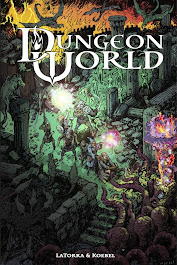Barbarians Versus. That title sure conjures up a very specific image, doesn't it? An image of muscled brute of a man charging down from the hills, loincloth fluttering in the wind and at least one axe raised above a face tangled in beard. At the bottom of the hills is something, it doesn't matter what. Whatever it is will be destroyed or pillaged. Barbarians Versus is exactly what you expect.
I'm not sure when or why I purchased this game. I found it in my DriveThruRPG library, so I must have bought it at some point. Maybe it was on sale? Perhaps it was in one of those charity bundles? I don't know. What I do know is that I had to take a look.
Once everyone has their barbarians ready it is time to go raiding. At this point the game moves into traditional GM/Player territory. The barbarians will stumble across the aliens and proceed to get into trouble. This is all handled with the old back and forth between GM and Player that anyone that has played a tabletop RPG should be familiar with.
The core mechanic of the game, that which you will be using whenever your barbarians actually want to do something is dead simple. You select the relevant attribute and add one die for each point in it you have, then you add more dice goals (or what your barbarian bleeds for), your clan, equipment and abilities. Then you subtract any penalties from that you might have from fears or use of abilities. Then you roll your mitfull of dice and total them. If your number is higher than the GM's target you win the test and something good happens. Otherwise, you are at the GM's mercy.
There isn't much else to say about the system or the rules. There are some sections on creating new abilities and things, which are going to be useful for anyone that wants to play this for more than one or two sessions, and a fun little GM section that has some ideas and tips. There is also a section on getting your barbarian drunk, a necessity for a game like this.
Barbarians Versus is available on DriveThruRPG for $5.
I'm not sure when or why I purchased this game. I found it in my DriveThruRPG library, so I must have bought it at some point. Maybe it was on sale? Perhaps it was in one of those charity bundles? I don't know. What I do know is that I had to take a look.
What is it?
Barbarians Versus is a short, 32 page RPG from Mystic Ages Publishing. Players take on the roles of the titular barbarians and proceed to wreck shit up. By default the game is set in a typical fantasy universe with one tiny, little twist. When the barbarians arrived for their annual pillaging of the kingdoms they discovered that reptilian aliens have conquered the kingdom.How does it work?
The game starts with everyone, except for the person in the role of the GM, creating a barbarian. This is a straightforward process that has each player naming their character; creating a clan; distributing 20 points among 5 attributes (Smash, Throw, Feet, Craftiness, Contemplating.), special abilities and equipment; creating a warcry and coming up with some goals and fears. This sounds like a lot more than it really is, all of these rules are clearly communicated across just five pages.Once everyone has their barbarians ready it is time to go raiding. At this point the game moves into traditional GM/Player territory. The barbarians will stumble across the aliens and proceed to get into trouble. This is all handled with the old back and forth between GM and Player that anyone that has played a tabletop RPG should be familiar with.
The core mechanic of the game, that which you will be using whenever your barbarians actually want to do something is dead simple. You select the relevant attribute and add one die for each point in it you have, then you add more dice goals (or what your barbarian bleeds for), your clan, equipment and abilities. Then you subtract any penalties from that you might have from fears or use of abilities. Then you roll your mitfull of dice and total them. If your number is higher than the GM's target you win the test and something good happens. Otherwise, you are at the GM's mercy.
There isn't much else to say about the system or the rules. There are some sections on creating new abilities and things, which are going to be useful for anyone that wants to play this for more than one or two sessions, and a fun little GM section that has some ideas and tips. There is also a section on getting your barbarian drunk, a necessity for a game like this.
Final thoughts.
Fun is the word here. The theme of the game is what sells it. If lighthearted barbarian hijinks sounds like a good time to you then you will like this game. If not, you won't. The system hardly even enters the equation. It does its job, it is simple and it works. It doesn't do anything special and it doesn't do anything bad either. It's the kind of system that gets out of the way so that you can have fun bashing things with your barbarian.Barbarians Versus is available on DriveThruRPG for $5.







